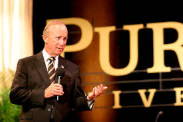What do Mitch Daniels, Dwight Eisenhower, and Robert E. Lee have in common? Higher education leadership that looks surprisingly similar across 150 years.
Purdue University President Mitch Daniels, former Governor of Indiana, Director of the Office of Management and Budget, and CEO of Eli Lilly & Company, has garnered lots of attention.
Daniels’s achievements at Purdue reflect his prior leadership as a financial steward and aggressive innovator. He seeks a clearer understanding of a degree’s value to students and families. Daniels has made a priority of spending time with students and employers to learn their views of higher education as “consumers.” He shattered tradition and froze tuition after decades of cost increases. He has a first-of-its-kind partnership with Amazon, allowing students faster and cheaper access to textbooks. He is relentless in cutting red-tape for new academic programs and more innovative approaches to degree attainment.
University presidents Robert E. Lee and Dwight Eisenhower acted much like Daniels. After a 36-year career as a soldier, Lee was president of Washington College from 1865 to 1870. Lee overhauled the college’s curricula, raised impressive amounts of money, and increased enrollment 400%. He met with students and set a tone with his own conduct—molded from military duty—for their growth as young adults. The student interaction revitalized Lee’s outlook after the Civil War.
Dwight Eisenhower followed up a military career—he was commander of Allied forces in North Africa and Europe during World War II—as president of Columbia University from 1948 to 1953. He secured massive donations of money, talked often with students, and worked to leave an imprint on academics. Eisenhower emphasized the university’s role in producing the nation’s best citizens and building national strength in a time of danger, threats, and enemies.
Of the three, Daniels has been the least political. Eisenhower served the US government in national security roles; Columbia granted him an “indefinite leave of absence” to do so. He refused to hire Communists as faculty or staff. Lee testified before Congress on Civil War issues. He intervened in several racial incidents involving his students and local residents. Social commentators watched him closely for any conduct that hinted at his loyalties from the Civil War.
The greatest similarity between Daniels, Eisenhower, and Lee is their lack of a professional educational background. Their experiences outside higher education informed their leadership inside higher education. Their opponents often seized upon this non-university record as fodder for criticism. None of the three presidents backed down in the face of such opposition.
Robert E. Lee died while university president. Dwight Eisenhower acquired presidential experience of a different sort. For Mitch Daniels, the rest of the story is yet to be written. But whatever comes next, he joins an impressive pair who left their mark as university leaders.








